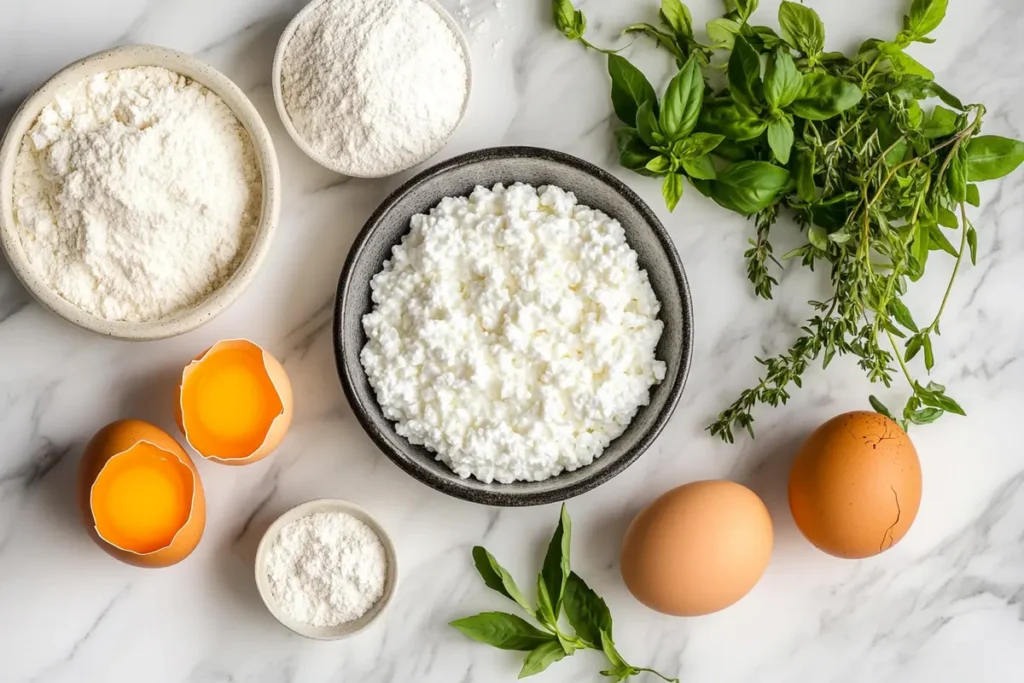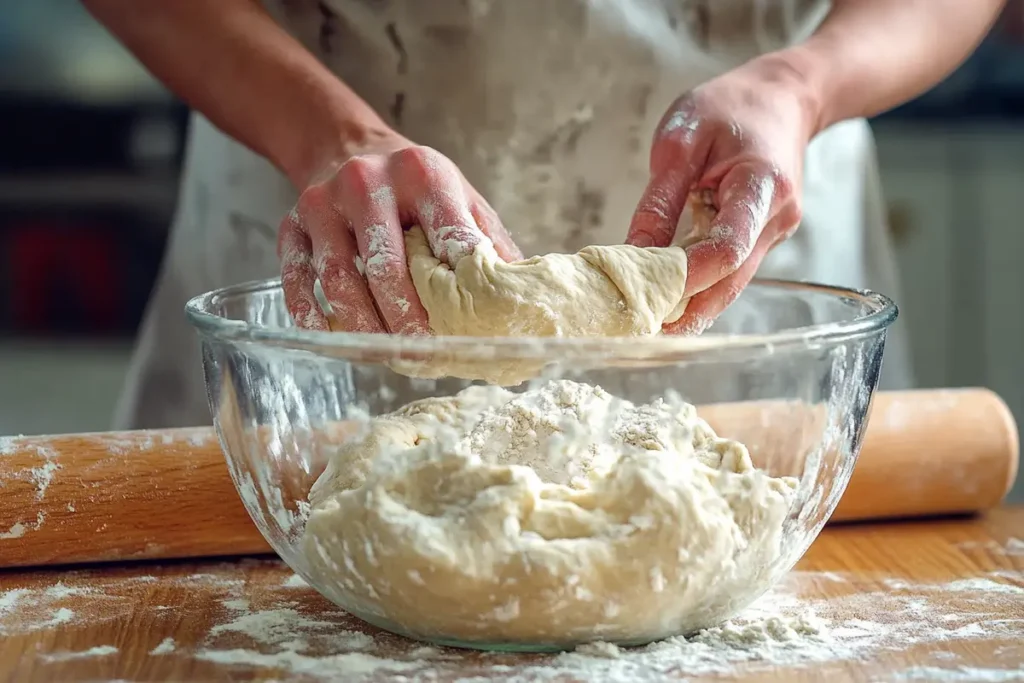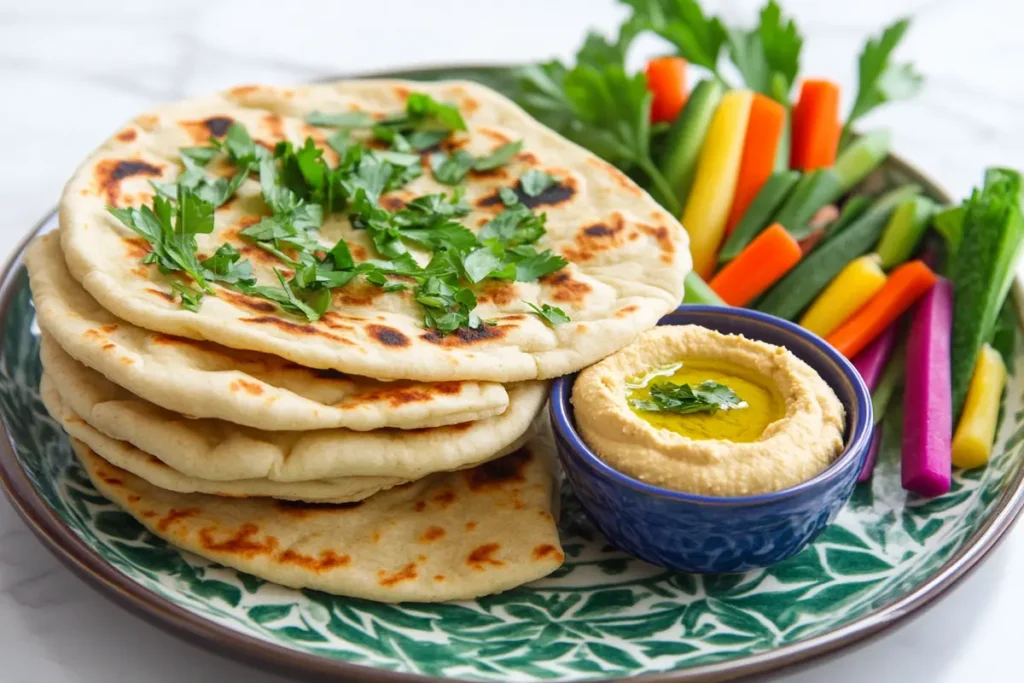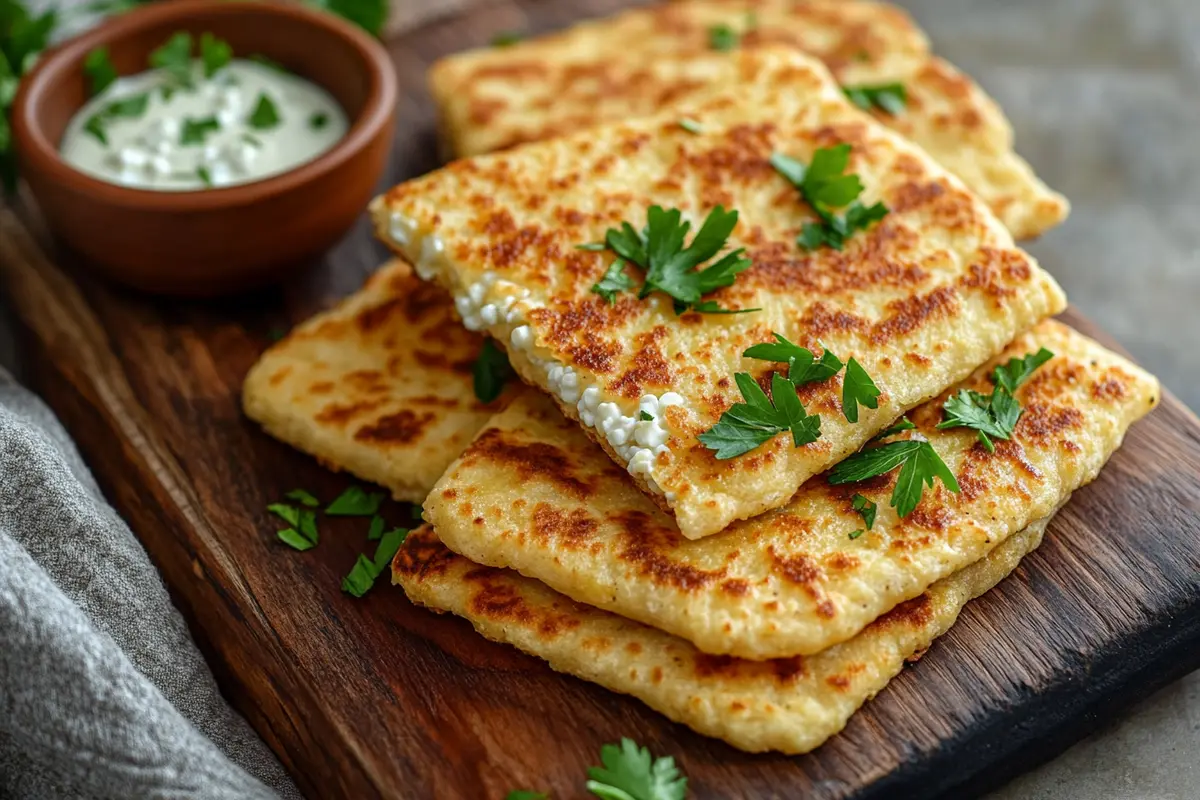Flatbreads have been a beloved staple worldwide for centuries, but the cottage cheese flatbread recipe brings a modern, healthy twist to this timeless favorite. Combining the richness of cottage cheese with simple pantry staples, this flatbread is not only delicious but also packed with nutrients. Whether you’re looking for a wholesome breakfast, a satisfying lunch, or a creative snack, this recipe has you covered. In this article, we’ll explore everything you need to know, from the health benefits of cottage cheese to step-by-step preparation tips and creative serving ideas. Let’s dive right into this exciting culinary journey!
Introduction to Cottage Cheese Flatbread
What Is Cottage Cheese Flatbread?
Cottage cheese flatbread recipe is a delightful combination of fluffy dough and the creamy tang of cottage cheese. This recipe stands out from traditional flatbreads because the cottage cheese adds a unique texture and flavor while also boosting the nutritional profile. Unlike store-bought flatbreads, this homemade cottage cheese flatbread recipe ensures you’re getting only wholesome ingredients without preservatives or additives.
Health Benefits of Cottage Cheese
Rich in protein and low in fat, cottage cheese is a powerhouse ingredient for anyone looking to maintain a healthy diet. Not only is it high in calcium, promoting strong bones, but it also contains essential vitamins like B12 and riboflavin. The probiotics in cottage cheese can aid digestion, making it a fantastic choice for gut health. Incorporating this cheese into flatbread gives you a snack or meal that’s both indulgent and nourishing.
Popularity and Trends
In recent years, cottage cheese flatbread recipe ideas have gained popularity among foodies and health enthusiasts alike. TikTok trends and Instagram reels have showcased the versatility of cottage cheese flatbreads, inspiring home cooks to experiment with different toppings, fillings, and techniques. This cottage cheese flatbread recipe has become a staple for those who want a quick, easy, and nutritious addition to their meal rotation.
Ingredients and Equipment
Essential Ingredients for Cottage Cheese Flatbread
To create the perfect cottage cheese flatbread, you’ll need a handful of simple, readily available ingredients. These components come together harmoniously to deliver a rich, flavorful, and healthy flatbread.
- Cottage Cheese: The star of the show! Choose a creamy, full-fat cottage cheese for the best flavor, or go with a low-fat version for a lighter option. Make sure it’s fresh for optimal texture.
- All-Purpose Flour: This forms the foundation of the dough. If you’re gluten-sensitive, substitute with almond flour or a gluten-free blend for a similar texture.
- Eggs: Adding eggs to the dough binds the ingredients together, creating a softer, more pliable flatbread.
- Baking Powder: Essential for giving the dough a slight rise, ensuring a fluffy yet chewy texture.
- Salt: A pinch of salt enhances the flavors and balances the richness of the cheese.
- Optional Add-Ins: Herbs like parsley, dill, or chives can elevate the flavor, while garlic powder or a touch of black pepper adds depth.

Choosing the Right Cottage Cheese
Not all cottage cheeses are created equal. For this cottage cheese flatbread recipe, it’s crucial to select one with the right consistency. A small-curd variety is ideal, as it blends easily with the dough. Avoid overly watery cottage cheese—it can make the dough sticky and hard to handle. Draining excess liquid before using can make a big difference.
Additional Ingredients for Flavor Enhancement
While the basic recipe is delicious, you can customize it to suit your taste. Add grated Parmesan for a cheesy kick, sprinkle in red pepper flakes for heat, or mix in nutritional yeast for a subtle umami flavor.
Necessary Equipment and Tools
Having the right tools can simplify the process and ensure consistent results. Here’s what you’ll need:
- Mixing Bowls: One large bowl for combining wet and dry ingredients and a smaller one for prepping any add-ins.
- Rolling Pin: Ensures an even thickness for your flatbread.
- Non-Stick Skillet or Baking Sheet: Choose a good-quality non-stick skillet for stovetop cooking or a baking sheet if you’re opting to bake.
- Silicone Spatula or Wooden Spoon: Handy for mixing without sticking.
- Kitchen Scale (Optional): For precise measurements, especially when working with flour.
Step-by-Step Preparation
Preparing the Dough
Creating the perfect cottage cheese flatbread starts with a well-prepared dough. This process is simple and doesn’t require advanced skills or equipment, making it accessible even for beginners.
Mixing Wet Ingredients
- In a large mixing bowl, combine 1 cup of cottage cheese and 1 large egg. Whisk the mixture until smooth and creamy. If the cottage cheese is too chunky, you can use a fork or an immersion blender to break it down further.
- Add a tablespoon of olive oil to the mixture for added moisture and a subtle richness.
Incorporating Dry Ingredients
- Gradually sift in 1 cup of all-purpose flour and 1 teaspoon of baking powder into the wet mixture. Stir gently with a spatula or wooden spoon to avoid overmixing.
- Sprinkle in a pinch of salt and any optional seasonings (e.g., garlic powder, parsley, or chives). If the dough feels too sticky, add a tablespoon of flour at a time until it reaches a workable consistency.
Shaping the Flatbread
Once the dough is ready, it’s time to shape it into perfect rounds or desired shapes for cooking.
Rolling Techniques for Even Thickness
- Lightly dust your work surface with flour to prevent sticking. Place the dough on the floured surface and gently knead it a few times to ensure it’s smooth and pliable.
- Divide the dough into equal portions—about 4-6 pieces, depending on your preferred flatbread size.
- Roll each portion into a ball, then flatten it with your hands or a rolling pin to about 1/4-inch thickness. For uniformity, use parchment paper to guide the rolling process.

Pro Tip: Cover the rolled-out dough with a damp cloth if you’re not cooking immediately to prevent it from drying out.
Cooking Methods
Baking the Flatbread
Baking is one of the easiest and most consistent methods for preparing cottage cheese flatbread. It delivers a golden, slightly crisp texture while maintaining the softness inside.
Oven Temperature and Timing
- Preheat your oven to 375°F (190°C) and line a baking sheet with parchment paper or a silicone baking mat. This prevents sticking and ensures even cooking.
- Place the rolled-out flatbread dough on the prepared baking sheet, leaving a small gap between each piece to allow for slight expansion.
- Bake for 10-12 minutes, flipping halfway through, until the flatbreads are lightly golden on both sides. For an extra-crispy finish, turn on the broiler for the last 1-2 minutes, keeping a close eye to prevent burning.
Alternative Cooking Methods
Stovetop Preparation
Cooking on a stovetop yields flatbreads with a slightly charred, rustic flavor that’s reminiscent of traditional techniques.
- Heat a non-stick skillet or griddle over medium heat and lightly grease it with olive oil or cooking spray.
- Place one flatbread at a time into the skillet and cook for 2-3 minutes on each side. Flip when you see bubbles forming and the edges begin to lift.
- For added flavor, brush the cooked flatbreads with melted butter or a sprinkle of herbs while still warm.
Air Fryer Method
Using an air fryer is a quick and efficient way to cook cottage cheese flatbread with minimal oil.
- Preheat your air fryer to 350°F (175°C). Line the basket with parchment paper or lightly grease it.
- Place the flatbreads in a single layer inside the basket, ensuring they don’t overlap.
- Cook for 5-7 minutes, flipping halfway through, until the flatbreads are golden and puffed.
Serving Suggestions
Creative Toppings and Variations
One of the best things about cottage cheese flatbread is its versatility. Whether you prefer savory or sweet, the options are endless. Here are some inspiring ideas to make every bite unforgettable:
Savory Options
- Classic Mediterranean: Top with hummus, cherry tomatoes, olives, and a sprinkle of feta cheese for a refreshing taste of the Mediterranean.
- Herb and Garlic Butter: Brush warm flatbreads with melted garlic butter and sprinkle with fresh parsley for a simple yet flavorful option.
- Protein-Packed Delight: Add grilled chicken, spinach, and a drizzle of tahini sauce to turn your flatbread into a hearty meal.
- Vegan Twist: Spread on avocado or vegan cream cheese, then pile on arugula, cucumber, and roasted red peppers.
Sweet Combinations
- Honey and Berries: Spread a thin layer of cream cheese or Greek yogurt, then top with fresh berries and a drizzle of honey.
- Nut Butter Bliss: Add almond or peanut butter, banana slices, and a sprinkle of cinnamon for a sweet and satisfying treat.
- Cottage Cheese Dessert: Use extra cottage cheese as a topping, mix it with honey or maple syrup, and add a few nuts for crunch.
Pairing Flatbread with Dishes
Flatbreads can be a delicious side dish or the star of the meal. Here are some pairings to try:
- With Soups: Serve warm cottage cheese flatbread alongside creamy tomato soup, minestrone, or lentil soup for a comforting combination.
- As a Wrap: Use the flatbread as a base for wraps filled with grilled veggies, falafel, or marinated tofu.
- With Dips: Pair flatbread with flavorful dips like tzatziki, baba ganoush, or salsa.
- For Breakfast: Make it a morning treat by serving it with scrambled eggs, smoked salmon, or a dollop of Greek yogurt.

Nutritional Information
Health Benefits of Cottage Cheese Flatbread
Not only is cottage cheese flatbread delicious, but it also boasts an impressive nutritional profile. Packed with protein, calcium, and essential vitamins, this recipe is a fantastic addition to a balanced diet.
Protein Content Analysis
One of the standout features of this flatbread is its high protein content. Thanks to the cottage cheese and eggs in the dough, you’ll enjoy a nutrient-rich snack or meal that keeps you full for longer. Protein supports muscle repair, boosts metabolism, and helps maintain healthy skin and hair.
Calorie and Macronutrient Breakdown
Here’s a rough breakdown of the nutritional values per serving (based on standard ingredients):
- Calories: Approximately 180–200
- Protein: Around 8–10 grams
- Carbohydrates: 20–25 grams
- Fat: 5–7 grams
This makes it an excellent option for those following a high-protein or balanced diet. By using whole-grain or almond flour, you can reduce the carbohydrate content while increasing fiber.
Low-Fat and Gluten-Free Modifications
For those looking to tailor the recipe to specific dietary needs, consider the following options:
- Low-Fat Version: Use low-fat or fat-free cottage cheese to significantly reduce the fat content while retaining its creamy texture.
- Gluten-Free Alternative: Substitute the all-purpose flour with almond flour, coconut flour, or a gluten-free flour blend. Keep in mind that some adjustments to the liquid ratio may be necessary.
Probiotic and Digestive Benefits
Cottage cheese is a natural source of probiotics, which promote gut health by supporting a healthy balance of bacteria in the digestive system. Combined with other wholesome ingredients, this flatbread becomes more than just a tasty treat—it’s a functional food that supports overall well-being.
Storage and Reheating
Proper Storage Techniques
Storing your cottage cheese flatbread correctly ensures it stays fresh and delicious for days. Whether you’ve made a small batch or have leftovers, these tips will keep your flatbread in excellent condition.
Room Temperature Storage
- If you plan to consume the flatbread within 1–2 days, store it in an airtight container or wrap it tightly in aluminum foil. Keep it at room temperature in a cool, dry place away from sunlight to prevent it from drying out.
Refrigeration
- For longer storage, refrigerate the flatbread. Wrap each piece individually in plastic wrap or parchment paper, then place them in a sealed container or zip-top bag. Properly stored, they can last up to 4–5 days in the refrigerator.
Freezing the Flatbread
- To preserve your flatbread for weeks, freeze it. Once the flatbread has cooled completely, layer parchment paper between each piece to prevent sticking. Store them in a freezer-safe bag or container. They can remain fresh for up to 3 months in the freezer.
Reheating Methods for Optimal Taste
Reheating cottage cheese flatbread correctly is essential for restoring its original texture and flavor. Here are the best methods:
Oven Reheating
- Preheat your oven to 350°F (175°C). Place the flatbreads on a baking sheet and cover them lightly with aluminum foil to prevent them from drying out. Heat for 5–7 minutes or until warm and soft.
Stovetop Reheating
- Heat a skillet over medium heat and lightly grease it with olive oil or butter. Warm each flatbread for about 1–2 minutes on each side. This method enhances the crispness of the exterior.
Microwave Reheating
- If you’re short on time, wrap the flatbread in a damp paper towel and microwave it for 20–30 seconds. While this method is quick, it may slightly alter the texture, making the flatbread softer.
Reheating Frozen Flatbread
- There’s no need to thaw frozen flatbread before reheating. Use the oven or stovetop methods, adding an extra minute or two to the heating time.
Frequently Asked Questions (FAQs)
Can I use non-fat cottage cheese for this recipe?
Absolutely! Non-fat cottage cheese works well in this cottage cheese flatbread recipe and can reduce the overall fat content. However, it may slightly alter the texture and richness of the flatbread. To balance this, consider adding a teaspoon of olive oil or a small dollop of Greek yogurt for extra moisture.
How do I prevent the flatbread from becoming soggy?
Soggy flatbread usually results from excessive moisture in the dough or toppings. To prevent this:
- Drain any excess liquid from the cottage cheese before mixing it into the dough.
- Avoid overloading the flatbread with wet toppings like sauces or vegetables. Instead, pat toppings dry before adding them.
- If using a skillet or oven, make sure the flatbread is cooked thoroughly to remove any residual moisture.
What are some gluten-free alternatives for this recipe?
For a gluten-free version, replace all-purpose flour with:
- Almond flour: Adds a nutty flavor and keeps the flatbread soft.
- Coconut flour: Works well but may require additional liquid due to its absorbent nature.
- Gluten-free flour blends: These are pre-mixed options that mimic the texture of regular flour.
Experiment with these options to find the one that suits your taste and dietary needs.
How can I make the flatbread crispier?
For a crispier flatbread, try these tips:
- Roll the dough thinner (about 1/8 inch) before cooking.
- Use a high heat setting when cooking on the stovetop or in the oven.
- Brush the surface with olive oil or melted butter before baking or frying.
- Add a sprinkle of grated Parmesan or nutritional yeast to the dough for an extra crispy crust.
What dishes pair well with cottage cheese flatbread?
This versatile flatbread pairs well with a variety of dishes:
- Soups: Tomato bisque, lentil soup, or creamy mushroom soup.
- Dips: Hummus, tzatziki, baba ganoush, or a tangy yogurt dip.
- Salads: Greek salad, Caesar salad, or a light arugula and pear salad.
- Proteins: Grilled chicken, roasted tofu, or sautéed shrimp.
Conclusion
Cottage cheese flatbread is a simple yet versatile recipe that’s perfect for any meal. With its high protein content, easy preparation, and endless topping possibilities, it’s a healthy and delicious option for both beginners and experienced cooks. Try it today and enjoy a wholesome, homemade treat!

